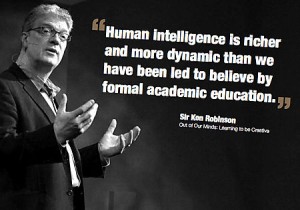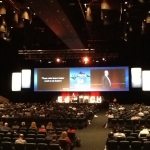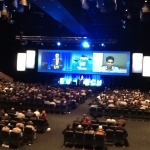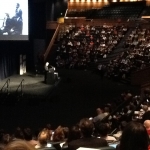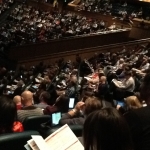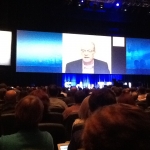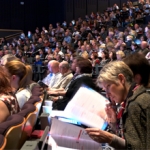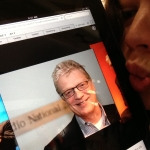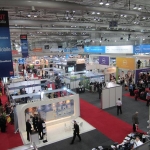
Edutech 2013!
EduTECH is Australia’s largest education technology event. In 2013, EduTECH hosted a massive conference and masterclasses, with more than 3600 delegates and 150 exhibitors. We were treated to some great speakers from around the world including Sir Ken Robinson, Salman Khan, Alan November, Ewan McIntosh, Daniel Pink…the list goes on. The discussions, workshops and networking provided many opportunities for educators using technology to improve learning outcomes.
Just for fun, an iMovie I made to describe the experience to colleagues.
Notes and reflections from some sessions at EduTech 2013
Daniel Pink
Looking at what motivates people is obviously crucial for educators. How exciting to see a world leader in this area talk about how we can motivate our students to learn! If you’d like to see a summary of Daniel Pink’s theories of motivation, click here, or read on to see some key ideas and thoughts from his presentation at EduTech.
The underlying laws of motivation seem to be that rewarding positive behaviour will result in more of that behaviour, an in contrast, punishing negative behaviour will reduce the behaviour. But is it that simple in education, a place where rewards for conforming abound and plenty of punishment awaits failure?
Daniel Pink presents three motivators for complex and creative tasks;
1. Autonomy
2. Mastery
3. Purpose
‘If…then‘ rewards (controlling contingent rewards) are good for short term or simple behavioural change, but for more complex and long-term results, the kind of motivation we know will benefit our students in their journeys as lifelong learners, we need to seek out new strategies. If…then rewards get our attention, and we do like rewards, but the frame of mind it promotes is not optimal for all tasks…yet we use these kinds of rewards as a matter of course in education.
Some studies have shown that systems for motivation that rely on an expected reward for an activity students already love can actually be counter-productive, even damaging to their enjoyment and/or engagement with that activity.
In simple or mechanical tasks, bigger rewards equalled improved performance. However, when even rudimentary cognitive skill becomes a factor, performance decreases.
Teachers should aim to be facilitators, leading their students to autonomy. We do not produce our best work in a controlling environment; when the focus is ‘comply/apply’, we often ‘defy’. And, for compliant students, ‘complying’ may represent a wasted opportunity – we want students to thrive, exploring their world, taking risks, pursuing individual learning goals with passion, rigour and pride. Creativity is hindered by constraints. Engagement vs. compliance is achieved through self-management (autonomy).
If people know why they are doing something, it has purpose, they do it better. When students believe they are getting better at something they understand and that they know matters, they do it best.
To attain mastery, students must see the progress they make. Feedback and reflection are closely related to mastery. Students need to be shown when they are making progress, positive steps forward, and feedback lets them know. Rich, regular and robust feedback is meaningful. for high performance, goals should be set by students, and monitored by students with teacher support.
Learn from artists…
Art gives the world something that is missing. Artists see problems and questions that others don’t, they find what is missing before others know it is not there. Artists produce their best work, the most creative work, when they work without constraints. A few parameters can help define a task or suggest a direction, but if you want break-through work, it needs to be ‘non-commissioned’.
Schools can foster ‘break-through’ work by implementing strategies that combine autonomy, motivation and mastery – allow students time to follow their passions and interests, but expect results; high standards + autonomy = best work.
Ideas;
* ‘FedEx/Shipping Day’ A day where students can follow their own paths, but where a product or idea must be demonstrated or ‘delivererd’, overnight.
* ’10 per cent Time’ Students use a small amount of their class time for a large amount of personal growth, free from constraints.
* ‘Friday evening experiments’ Create a regular time for ‘passion-pursuits’, a place where anything goes as long as the learning is not related to work/school.
We can motivate our students successfully if we can show them that what they are learning is significant, help them to see their progress, and provide opportunities for them to engage with the learning themselves.
Daniel Pink’s classic TED Talk…
Ewan McIntosh
“If all you can do is solve problems, you are not going to survive in the workplace.” Finding the problems no-one else has solved, intriguing problems, is what creativity and innovation is all about.
Creative people don’t just talk about curiosity…they have a process.
Immersion
Synthesis
Ideation
Prototyping
This is design thinking…the notion of feedback and feed forward. And, prototyping is NOT drafting.
Design thinking, coupled with the processes of education, gives you Ewan McIntosh’s ‘Six Pillars of Innovation in Learning‘;
1. Challenge
2. Collaborate
3. Responsibility
4. Respect
5. Real Life (know why!)
6. Choice (authentic choice)
Some great little moments:
“Good energy is infectious.”
“Protect curiosity.”
“Can deep learning occur in 45 minute blocks?” Maybe we need to rethink timetables.
Some favourite moments…
Stephen Heppell
Synchronous is sovereign. Now is valued, recorded isn’t.
Informed consumers improve service.
Real time with data improves decisions by all.
Technology reduces costs dramatically
Start looking at Stephen Heppell’s collection of resources at this link.
 Google
Google
7 million in the world, 2 million are online…
For our kids, their first device was not a desk top computer. iPhone exposure is now from birth.
ICT is not PowerPoint…students staring at a projector while one student talks to text and images is not 21st Century learning. We can do better.
Gary Stager
If you email Gary at hey@stager.org, you will get a link with a mountain of great resources for teaching and learning with technology. And check out the Super Sylvia Maker Show to see the kind of learning Gary explores in his presentations.
Great question to ask yourself everyday – As a teacher, how can I make the next 7 hours the best 7 hours of a child’s life? No pressure!
How can we REALLY use technology in the classroom – ICT is not about PowerPoint or looking stuff up – we should be using technology to create. Students are already doing it. The don’t need to be taught how to do things – they will find out how by doing and then go further, and that is so much more valuable. Programming is the future and the ‘Maker Movement’ gives us direction for educational design that promotes skills and a mindset for a world beyond school.
“The best thing we can do as adults is become more interesting.”
Interestingly, Gary also challenged us to reconsider teacher training, issuing the an almost throw-away line that there was no need to equip teachers with professional development that focused on ‘teachers learning to use technology’. I believe his main argument stemmed from a belief that three year-old children were able to navigate their way around an iPad and therefore teachers should also be expected to use devices of this kind. It made me think, and at the moment I’m not convinced… Often the barriers are not about ‘difficulties’, more ‘mindsets’ and fear. I think it’s important to remember that just like students, teachers are individuals, with different strengths, weaknesses, backgrounds and learning styles. I certainly believe we can ill-afford to lose exceptional, but technology-wary teachers from the system. I’m not suggesting that teachers should not be on the pathway to technology integration in their classrooms – I am saying is that the support they need, which may involve explicit teaching for technology usage and professional development that does come at a cost…and I believe it is worth it – for our teachers and our students.
Ken Robinson
Joining our conference via video link, Sir Ken talked about creativity and innovation in teaching. Spending an hour listening to his words of wisdom, it’s hard to believe our schools are generally operating in such contrast to the types of teaching and learning experiences Sir Ken advocates.
If you’d like to see more of his presentations and ideas for a redefinition of our education system, check out our collection of Ken Robinson resources here.
Ken Robinson on creativity, technology and education.
Create a climate of possibilities in your classroom by recognising the following principles:
1 Human life is diverse. Your students are all different and this principle is contradicted by systems of conformity in schools, a system predicated on conformity father than diversity.
2 Human life is essentially creative. This fundamental principle achknowledges that creativity is not an exotic feature unique to a small number of ‘lucky’ or special people. The human capacity for creativity is endless and this is demonstrated in the incredible diversity of the hunan experience. People live a unique existence and we don’t get a resume with a birth certificate – there are infinite possibilities for every one of us.
“A really brilliant idea will kick up a storm of related ideas. They inflame the imagination of others. They cross pollinate until there is a forest of creativity. In that sense our lives are unpredictable, a product of the intersection of creative ideas and creative people. In contrast, education is a culture of finding the right answers.”
3. Life is not linear, it is organic. You can’t plan your own life…you can plot a course, but mapping out the journey step-by-step is impossible. One type of education is not suitable for all…and this should be obvious.
Life evolves on the basis of our decisions and our circumstances. The best educators understand that their role is to connect with people as individuals and connect them to their passions.

Alan November
“Using the technology as a thousand dollar pencil doesn’t make sense.”
Despite all the recent advances in technology over the last 20 years, there has been essentially no change in education, test scores, etc.
Technology has not fulfilled its promise for our students’ futures because there has been no process change.
The way you use technology as a tool is key.
Without process change, ‘the how’, ‘the what’ does not lead to improvement.
Flip learning is first example of process change. Flip learning recognises that the definition of learning is not about demonstrating an ability to repeat information, but rather, the understanding allows application of knowledge across new and different contexts.
Teaching tip: Ask your students to ask a question every day… Interaction/participation is impossible for the majority of learners in a classroom environment, but asking questions within a connected classroom model can allow 100 per cent participation. The hardest part of flipping is working out what questions you should be asking.
For further research, look to the work of Eric Mazur…
“The more of an expert you become in any field the more difficult it is to understand the struggles of a first time learner.”
EduTech 2014 is already being planned…read more here.
And if you STILL need more, check out this article from ABC’s William Cohen and the following is from an outstanding post on What Ed Said – great ideas, resources and links inspired by the conferences. Thanks, Edna Sackson for sharing your ’10 big ideas from EduTech 2013′…
1. Ownership
Enable choice. Foster independence. Encourage responsibility.
2. Collaboration
Learn together. Grow ideas. Build community.
3. Creativity
Experiment. Play. Make something.
4. Problem solving/finding
Think differently. Find solutions. Seek new problems.
5. Curiosity
Ask questions. Notice. Wonder.
6. Diversity
One size does not fit all. Differentiate. Personalize learning.
7. Flexibility
Rethink school. Create new spaces. Unlearn.
8. Relevance
Make it real. Solve real life problems. Create for an authentic audience.
9. Connection
Build a PLN. Flatten classroom walls. Participate.
10. Change
Do one new thing. Influence someone else. Shift the sand, one ‘teaspoon’ at a time…



